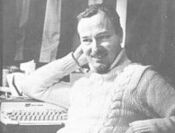John Brunner

John Brunner was born in Preston Crowmarsh, near Wallingford in Oxfordshire, and went to school at St Andrew's Prep School, Pangbourne, then to Cheltenham College. He wrote his first novel, Galactic Storm, at 17, and published it under the pen-name Gill Hunt, but he did not start writing full-time until 1958. He served as an officer in the Royal Air Force from 1953 to 1955, and married Marjorie Rosamond Sauer on 12 July 1958
At the beginning of his writing career Brunner wrote conventional space opera pulp science fiction. Brunner later began to experiment with the novel form. His 1968 novel "Stand on Zanzibar" exploits the fragmented organizational style John Dos Passos invented for his USA trilogy, but updates it in terms of the theory of media popularised by Marshall McLuhan.
"The Jagged Orbit" (1969) is set in a United States dominated by weapons proliferation and interracial violence, and has 100 numbered chapters varying in length from a single syllable to several pages in length. "The Sheep Look Up" (1972) depicts ecological catastrophe in America. Brunner is credited with coining the term "worm" and predicting the emergence of computer viruses in his 1975 novel "The Shockwave Rider", in which he used the term to describe software which reproduces itself across a computer network. Together with "Stand on Zanzibar", these novels have been called the "Club of Rome Quartet", named after the Club of Rome whose 1972 report The Limits to Growth warned of the dire effects of overpopulation.
Brunner's pen names include K. H. Brunner, Gill Hunt, John Loxmith, Trevor Staines, Ellis Quick, Henry Crosstrees Jr., and Keith Woodcott.
In addition to his fiction, Brunner wrote poetry and many unpaid articles in a variety of publications, particularly fanzines, but also 13 letters to the New Scientist and an article about the educational relevance of science fiction in Physics Education. Brunner was an active member of the organisation Campaign for Nuclear Disarmament and wrote the words to "The H-Bomb's Thunder", which was sung on the Aldermaston Marches.
Brunner had an uneasy relationship with British new wave writers, who often considered him too American in his settings and themes. He attempted to shift to a more mainstream readership in the early 1980s, without success. Before his death, most of his books had fallen out of print. Brunner accused publishers of a conspiracy against him, although he was difficult to deal with (his wife had handled his publishing relations before she died).[2]
Brunner's health began to decline in the 1980s and worsened with the death of his wife in 1986. He remarried, to Li Yi Tan, on 27 September 1991. He died of a heart attack in Glasgow on 25 August 1995, while attending the World Science Fiction Convention there
Log In to see more information about John Brunner
Log in or register now!
Series
Books:Stand on Zanzibar, April 2021
Trade Size / e-Book
|






 © 2003-2024
© 2003-2024